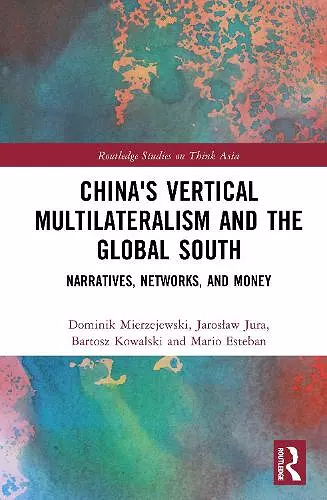China's Vertical Multilateralism and the Global South
Narratives, Networks, and Money
Dominik Mierzejewski author Bartosz Kowalski author Mario Esteban author Jarosław Jura author
Format:Hardback
Publisher:Taylor & Francis Ltd
Published:21st Oct '25
Currently unavailable, our supplier has not provided us a restock date

This book provides an in-depth analysis of China-led multilateralism and decodes China’s narratives, and political and business practices, both from theoretical and practical dimensions.
Introducing the mechanisms that govern China-led multilateral formats in what China sees as the Global South, the study offers a comparative analysis and checks whether China uses a one-size-fits-all strategy towards the selected case study formats and adopts a more differentiated regional approach. The case studies cover the following China-led multilateral formats: China-ASEAN, Forum on China-Africa Cooperation (FOCAC), China-Central and Eastern Europe, and China-CELAC. The authors introduce four primary practices of China’s management of relations within these platforms: executing discursive power, cultivating elite diplomacy, influencing public opinion, and navigating economic interactions to illustrate the bilateral and informal nature of China-led multilateralism practices. They argue that the bilateral approach is driven by China’s will to keep its paramount position within the formats and its pursuit to exploit the divisions among countries in these formats. Moreover, China’s relations with the Global South community are governed by informal networks that give the impression of non-interference and position China as the principal power due to these relationships’ inherent asymmetry. Cognizant of bilateral and informal drivers of China’s multilateral practices, the book compares China’s relations with selected case studies of countries under the multilateral umbrella: Brazil, Cambodia, Chile, Kenya, Poland, Serbia, South Africa and Thailand. It considers the growing tensions between China and the West surrounding the crisis of the COVID-19 pandemic, the centralisation of power in China and the Russian war in Ukraine.
Shedding light on China's policies and practices on bilateral and multilateral levels, this book will be of interest to researchers studying International Relations, Asian Politics, the politics of the Global South and Chinese Studies.
"China’s Vertical Multilateralism offers an innovative and critical analysis of China’s approach to multilateral institutions. It shows that behind China’s principled support of multilateralism, Beijing has developed a hierarchical approach that both enhances its own international influence and puts countries participating in these platforms in a situation of deepening and fragilizing dependence upon China. A must-read."
-- Jean-Pierre Cabestan, Senior Researcher Emeritus, French National Centre for Scientific Research, Professor Emeritus, Hong Kong Baptist University
"Xi Jinping has advocated the concept of 'true multilateralism,' but this incisive book explains why China’s approach is better characterized as 'vertical multilateralism' in which Beijing uses multilateral frameworks to advance bilateral initiatives. The authors’ thoughtful examination of this phenomenon in countries across the Global South demonstrates not only how this concept works in theory, but also how Chinese diplomats carry it out in practice. This book should be required reading for anyone interested in China’s evolving international engagement strategy."
-- Zack Cooper, American Enterprise Institute
"This book makes a significant and timely contribution to the study of China’s global strategy. Scholars of China have long examined the interplay between discourse, narrative power, and political practice within the country. But these dynamics are no longer confined to domestic politics—they now shape how China engages the world and projects its power globally. By introducing the concept of vertical multilateralism, the book offers a powerful new lens to understand China’s global strategy, especially in the Global South. It shows how Beijing externalizes core features of its domestic governance model—through discursive framing, the bilateralization of multilateral forums, and the deployment of economic statecraft—to (re)shape international relations on its own terms. The analytical framework proposed here is both timely and innovative. It captures the strategic logic of China's foreign policy toolkit, where discourse, elite-centred networks, and economic interdependencies work in concert to build asymmetrical, Sino-centric partnerships. This book is essential reading for scholars and practitioners alike—an insightful and much-needed guide to making sense of China's growing influence and the profound transformations it brings to global governance."
-- Marina Rudyak, Heidelberg University/The Decoding China Project
ISBN: 9781041082804
Dimensions: unknown
Weight: 630g
242 pages